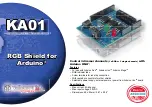
EPWMxINT
EPWMxTZINT
EPWMxSOCA
EPWMxSOCB
EPWMxSYNCI
EPWMxSYNCO
Time-base (TB) module
Counter-compare (CC) module
Action-qualifier (AQ) module
Dead-band (DB) module
PWM-chopper (PC) module
Event-trigger (ET) module
Trip-zone (TZ) module
Peripheral bus
ePWM module
TZ1
TZ3
to
EPWMxA
EPWMxB
PIE
ADC
GPIO
MUX
COMPxOUT
COMP
Digital Compare (DC) module
EQEP1ERR
CLOCKFAIL
EMUSTOP
Figure 3-2. Submodules and Signal Connections for an ePWM Module
shows more internal details of a single ePWM module. The main signals used by the ePWM module
are:
•
PWM output signals (EPWMxA and EPWMxB):
The PWM output signals are made available external to
the device through the GPIO peripheral described in the system control and interrupts guide for your device.
•
Trip-zone signals ( TZ1 to TZ6):
These input signals alert the ePWM module of fault conditions external to
the ePWM module. Each module on a device can be configured to either use or ignore any of the trip-zone
signals. The TZ1 to TZ3 trip-zone signals can be configured as asynchronous inputs through the GPIO
peripheral. TZ4 is connected to an inverted EQEP1 error signal (EQEP1ERR) from the EQEP1 module (for
those devices with an EQEP1 module). TZ5 is connected to the system clock fail logic, and TZ6 is connected
to the EMUSTOP output from the CPU. This allows you to configure a trip action when the clock fails or the
CPU halts.
•
Time-base synchronization input (EPWMxSYNCI) and output (EPWMxSYNCO) signals:
The
synchronization signals daisy chain the ePWM modules together. Each module can be configured to either
use or ignore its synchronization input. The clock synchronization input and output signal are brought out to
pins only for ePWM1 (ePWM module #1). The synchronization output for ePWM1 (EPWM1SYNCO) is also
connected to the SYNCI of the first enhanced capture module (eCAP1).
•
ADC start-of-conversion signals (EPWMxSOCA and EPWMxSOCB):
Each ePWM module has two ADC
start of conversion signals . Any ePWM module can trigger a start of conversion. Whichever event triggers
the start of conversion is configured in the Event-Trigger submodule of the ePWM.
•
Comparator output signals (COMPxOUT).:
Output signals from the comparator module in conjunction with
the trip zone signals can generate digital compare events.
•
Peripheral Bus:
The peripheral bus is 32-bits wide and allows both 16-bit and 32-bit writes to the ePWM
register file.
also shows the key internal submodule interconnect signals. Each submodule is described in detail in
its respective section.
Enhanced Pulse Width Modulator (ePWM) Module
SPRUH18I – JANUARY 2011 – REVISED JUNE 2022
TMS320x2806x Microcontrollers
245
Copyright © 2022 Texas Instruments Incorporated
Содержание TMS320 2806 Series
Страница 2: ......
















































